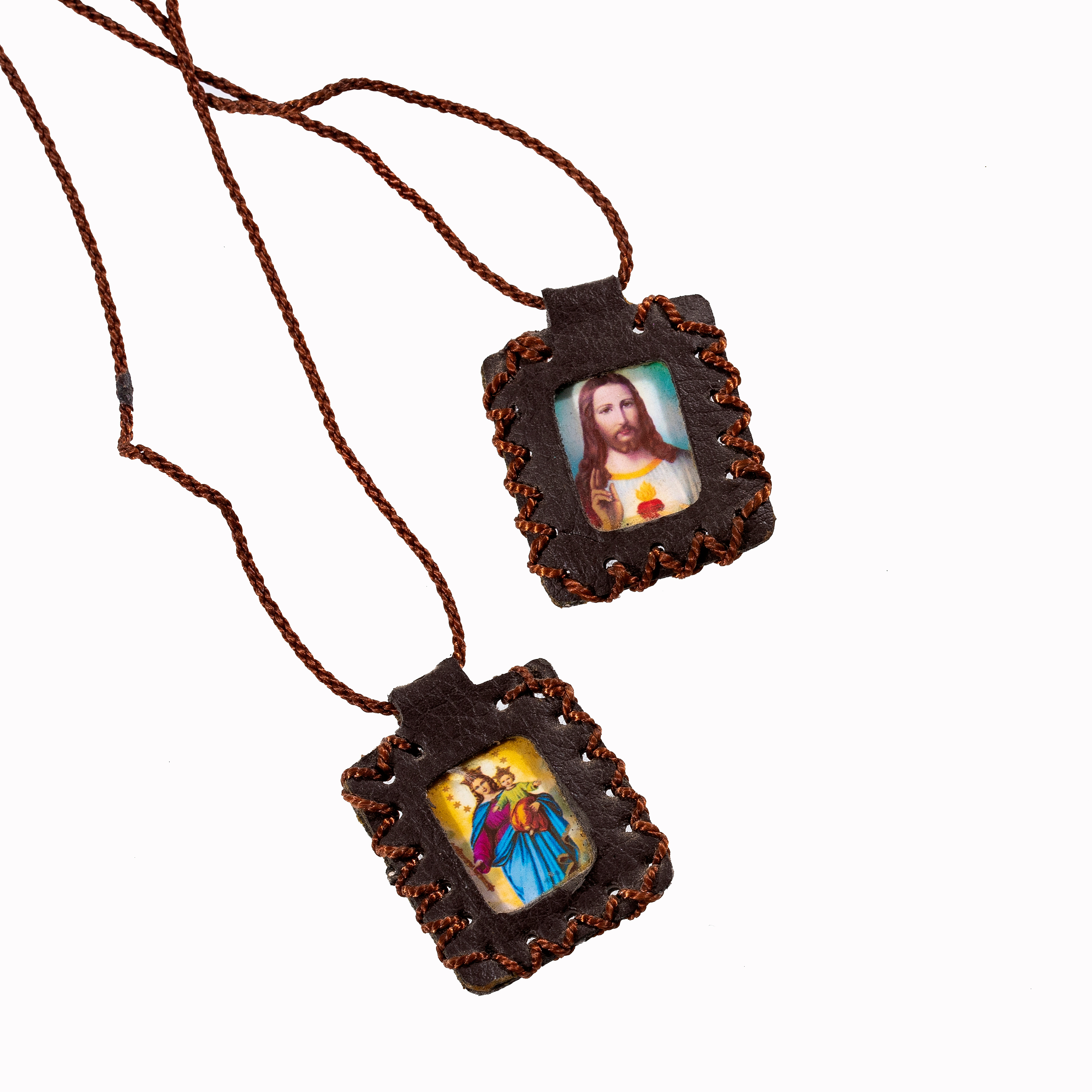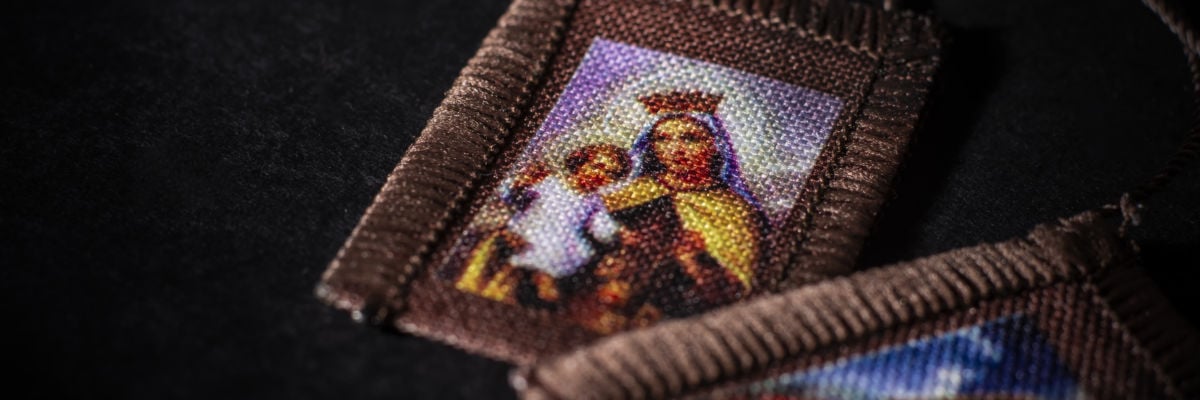
What Is the Brown Scapular?
The Brown Scapular of Our Lady of Mount Carmel is one of the most beloved sacramentals in the Catholic Church. Often called simply “the scapular,” because it is the oldest and most prominent among several others, the brown scapular consists of two small pieces of brown wool connected by cords and worn over one’s shoulders. In contrast to a purely ornamental necklace, the brown scapular is a visible sign of devotion to the Blessed Virgin Mary.
The word “scapular” comes from the Latin scapulae, meaning “shoulders.” Historically, the term first referenced a portion of the Carmelite Order’s habit, i.e., the long wool garment worn over the shoulders by the consecrated religious members of the order. In time, the lay faithful began wearing a smaller version as a way of sharing spiritually in Carmelite life and devotion to the Blessed Virgin Mary, the Mother of God.

The Origin of the Scapular
According to the pious Carmelite tradition, the Blessed Mother—in an apparition on July 16, 1251—gave the smaller sacramental to St. Simon Stock, a Carmelite friar. She instructed him that the faithful should wear the brown scapular as a sign of her protection, and she promised that those who die wearing it with devotion to her—and thus with faith in her divine Son Jesus, to whom she always leads (John 2:5)—would not suffer eternal fire.
Over time, the scapular sacramental, of which there are various, has become increasingly associated with Carmelite piety.. For many years, the brown scapular has been one of the Church’s mostly widely used sacramentals. Traditionally, as The Catholic Encyclopedia notes, there have been five “best known” scapulars, including the brown scapular:
Several scapulars may be attached to the same pair of strings or bands; each scapular must of course be complete, and must be attached to both bands. In many cases the five best known of the early scapulars are attached to the same pair of bands; this combination is then known as the “fivefold scapular.” The five are: the Scapular of the Most Blessed Trinity, that of the Carmelites, of the Servites, of the Immaculate Conception, and the Red Scapular of the Passion. When the scapulars are thus joined together, the bands must be of red wool, as required by the Red Scapular; it is customary to wear the Red Scapular uppermost and that of the Most Blessed Trinity undermost, so that the images specially prescribed in the case of the Red, and the small red and blue cross on the Scapular of the Blessed Trinity, may be visible.
The Feast of Our Lady of Mount Carmel is celebrated on July 16, which continues to be a day of special importance for scapular devotion.
What Is the Purpose of Wearing the Scapular?
The brown scapular is not a good-luck charm or “miraculous amulet,” as if one were guaranteed salvation simply by wearing it and apart from the grace of Christ. Rather, the Church recommends it as a sign of salvation when worn with faith, and therefore accompanied by prayer and the sacraments. The scapular promise is Mary’s maternal assurance that she intercedes for those who are devoted to her and her Son, and so who strive to live faithfully as her beloved sons and daughters (see Rev. 12:17).
In other words, the scapular points to a life of discipleship in our Lord Jesus Christ and his Catholic Church, not a magical shortcut. Wearing the scapular without repentance, prayer, and an ongoing faithful life in Christ would be vain and ineffective.
How to Wear the Scapular
Many Catholics ask, “How do you wear a scapular?” The scapular should be worn over the shoulders, with one piece of wool resting on the chest and the other on the back. Additionally, the following must be observed:
- Be enrolled in the confraternity by a priest.
- Wear it continually, although taking it off for a shower is fine, as is for cleaning it. In that light, we need to avoid scrupulosity.
- Commit to living a faithful Christian life.
Enrollment in the Brown Scapular
A Catholic may not simply buy a scapular and begin wearing it. The Church requires that a priest enroll the person. This one-time ceremony formally places the person under the protection of Our Lady of Mount Carmel and into spiritual union with the Carmelite family. After enrollment, a Catholic can replace the scapular freely when it wears out—and without repeating the enrollment ceremony.
Enrollment reflects that the scapular is not merely a private devotion but an important sacramental of the Church. Many parishes and Carmelite communities offer scapular enrollment, especially around July 16. If you have missed this time window in your parish, simply ask your parish pastor or associate priest to enroll you.
In 1910, Pope St. Pius X authorized—through the Holy Office—the wearing of a medal instead of the traditional brown scapular or other scapulars:
For the future all the faithful already inscribed or who shall be inscribed in one or other of the real Scapulars approved by the Holy See (excepting those which are proper to the Third Orders) by what is known as regular enrollment may, instead of the cloth scapulars, one or several, wear on their persons, either round the neck or otherwise, provided it be in a becoming manner, a single medal of metal, through which, by the observance of laws laid down for each scapular, they shall be enabled to share in and gain all the spiritual favors (not excepting what is known as the Sabbatine Privilege of the Scapular of Our Lady of Mount Carmel), and all the privileges attached to each.
The right side of this medal must show the image of Our Most Holy Redeemer, Jesus Christ, showing His Sacred Heart, and the obverse that of the Most Blessed Virgin Mary. It must be blessed with a separate blessing for each of the scapulars in which the person has been enrolled and for which the wearer wishes it to suffice. Finally, these separate blessings may be given by a single sign of the cross (unico crucis signo), whether in the act of enrollment or later at the convenience of those enrolled; it matters not how long after the enrollment or in what order they may have taken place; the blessing may be given by a priest other than the one who made the enrollment, as long as he possesses the faculty, ordinary, or delegated, of blessing the different scapulars—the limitations, clauses, and conditions attached to the faculty he uses still holding their force. All things to the contrary, even those calling for special mention, notwithstanding (Holy Office, Rome, December 16, 1910).
Gaining the Sabbatine Privilege of the Brown Scapular
As noted, the basic requirements to receive the promise of the brown scapular are enrollment, wearing the scapular, and living a committed Christian life. In addition, there is the Sabbatine Privilege, so named because the Blessed Mother promised that “she herself would graciously descend on the Saturday (Sabbath) after their death and liberate and conduct to heaven all who were in purgatory.” The Sabbatine Privilege is traditionally connected with Pope John XXII in 1322.
Gaining the Sabbatine Privilege is contingent on two additional and traditional requirements:
- Observe chastity—i.e., in conformity with the Sixth and Ninth Commandments—according to your state in life.
- Recite daily the Little Office of the Blessed Virgin Mary or the Liturgy of the Hours/Divine Office; or abstain from meat on Wednesdays and Saturdays (an exception is made for Christmas) in addition to the fast days prescribed by the Church.
Disclaimer: In more modern times, the Church has granted priest confessors the faculty to commute the condition of abstinence into other good works, e.g., a daily rosary of five decades. (Those bound to pray the liturgy of the hours, namely clerics and consecrated religious, fulfill this condition by praying the divine office.) In addition, a priest confessor is free to choose any suitable good work as the daily substitute for a lay person. For example, the commutation of Carmelite confessors has traditionally been seven “Our Fathers,” seven “Hail Marys,” and seven “Glory Be to the Fathers.” Some also join a scapular confraternity, sharing in the prayers and good works of the Carmelite Order.
Prayers of the Brown Scapular
Along with praying the Little Office of the Blessed Virgin Mary, the morning offering associated with the brown scapular is very popular among the sacramental’s devotees:
O my God, in union with the Immaculate Heart of Mary (kiss your brown scapular), I offer thee the Precious Blood of Jesus from all the altars throughout the world, joining with it the offering of my every thought, word and action of this day.
O my Jesus, I desire today to gain every indulgence and merit I can and I offer them, together with myself, to Mary Immaculate, that she may best apply them to the interests of thy Most Sacred Heart.
Precious Blood of Jesus, Save us!
Immaculate Heart of Mary, Pray for us!
Sacred Heart of Jesus, Have mercy on us!
Marian Devotion in the Scapular
The brown scapular reflects Mary’s titles of Our Lady of Mount Carmel, Blessed Mother, and her Immaculate Heart. In enrolling and wearing the scapular, Catholics consecrate themselves to Jesus Christ through his Blessed Mother.
The scapular is also tied to the Sacred Heart of Jesus and the Church’s broader teaching on sacramentals, as sacramentals help prepare us to receive the graces of the sacraments.
Read more about Marian consecration here.
What Is the Scapular Promise?
So, what does the “scapular promise” mean? According to the pious Carmelite tradition, Mary promised salvation to those who die clothed in the scapular, provided they live faithful Christian lives. Popes and saints have affirmed the scapular as a sign of salvation, but always within the context of the Church’s teaching: salvation comes through Christ and his Catholic Church, and sacramentals like the scapular dispose us to receive his grace more fruitfully.
Ultimately, again, the Blessed Mother always points us to her Divine Son, who is ever near to her.
Other Catholic Devotions
The brown scapular is not an isolated practice. It connects Catholics to centuries of devotion, especially in the Carmelite Order and in Marian confraternities. Like medals, holy water, or the rosary, the scapular is part of the Church’s treasury of sacramentals, with each sacramental designed to help us live out our Catholic faith to the fullest.
Some other devotions include the St. Benedict medal, the Miraculous Medal, and the Sacred Heart of Jesus.
The Feast of Our Lady of Mount Carmel
Every July 16, Catholics around the world celebrate the Feast of Our Lady of Mount Carmel. This date recalls Mary’s gift of the scapular to St. Simon Stock and renews the faithful’s devotion to her care. Parishes often hold enrollments on this day, marking the scapular not just as a personal devotion but also as an outward sign of the Faith and a symbol of communion in the mystical body of Christ, the Church.
Devotion to Mary in the Scapular
The Brown Scapular of Our Lady of Mount Carmel is one of the most recognizable Catholic devotions. In fact, in a culture in which wearing a crucifix necklace has become a secular trend, the brown scapular stands out. Ultimately, it is far more than just a necklace, or a simple piece of wool. It is a sign of a faith-filled life and a pledge of Mary’s protection.
For Catholics who wear the scapular with sincere devotion—and thus pray daily and frequent the sacraments—the Blessed Virgin Mary promises her help at the hour of death. The scapular remains, as the Carmelite Order has held, an instrument of grace and a visible reminder that we belong to Jesus through his Mother.
Related Content
Articles
Is the Scapular a Magic Charm?
How to Explain Sacramentals to Fundamentalists, Part I
Marian Apparitions for Protestants
Shop
Behold Your Mother: A Biblical and Historical Defense of the Marian Doctrines
20 Answers: Relics & Sacramentals
33 Days to Morning Glory: A Do-It-Yourself Retreat In Preparation for Marian Consecration
Q & As
The Scapular Promise and Eternal Security
Confirmation and the Brown Scapular
Can a Non-Catholic Wear a Scapular?
Podcasts
Would the Promise of the Brown Scapular Apply to the Second Coming?
When Is It Okay to Wear the Scapular Medal Instead of the Brown Cloth Scapular?


